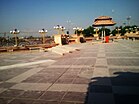This article may require cleanup to meet Wikipedia's quality standards. The specific problem is: wrong image sizes. (September 2023) |
Nasiriyah
ٱلنَّاصِرِيَّة Nassiriya Nasiriya | |
|---|---|
| Coordinates: 31°02′38″N 46°15′27″E / 31.04389°N 46.25750°E | |
| Country | |
| Governorate | Dhi Qar |
| District | Nasiriyah |
| Established | 1872 |
| Population | |
| • Estimate (2018)[1] | 558,446 |
Nasiriyah (UK: /ˌnæzɪˈriːə/ NAZ-irr-EE-ə, US: /ˌnɑːsɪ-/ NAH-sirr-; Arabic: ٱلنَّاصِرِيَّة, romanized: an-Nāṣiriyya, BGN: An Nāşirīyah, IPA: [ænnɑːsˤɪˈrɪjjæ]), also spelled Nassiriya or Nasiriya, is a city in Iraq, the capital of the Dhi Qar Governorate. It lies on the lower Euphrates, about 360 km (225 miles) south-southeast of Baghdad, near the ruins of the ancient city of Ur. Its population in 2018 was about 558,000, making it the ninth-largest city in Iraq.[1] It had a diverse population of Muslims, Mandaeans and Jews in the early 20th century;[2] today its inhabitants are predominantly Shia Muslims.[3]
Nasiriyah was founded by the Muntafiq tribe in the late 19th century during the Ottoman era.[4] It has since become a major hub for transportation.[3] Nasiriyah is the center of a date-growing area. The city's cottage industries include boat-building, carpentry and silver working.[5] The city museum has a large collection of Sumerian, Assyrian, Babylonian, and Abbasid artifacts. The ruins of the ancient cities of Ur and Larsa are nearby and the Euphrates merges with the Tigris for the final time about 10 kilometres from the city.
- ^ a b Major Cities Archived 26 July 2020 at the Wayback Machine City Population
- ^ Field Museum of Natural History, 1940, p. 258.
- ^ a b Mockaitis 2013, p. 291.
- ^ Çetinsaya 2006, p. 88.
- ^ Dabrowska & Hann 2008, p. 268.







